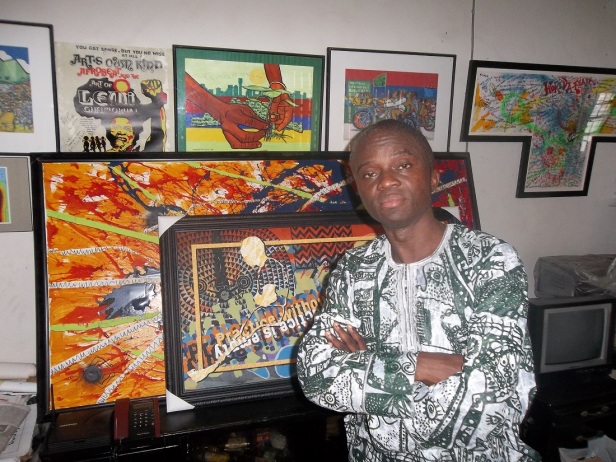
Before he turned 20, Lemi Ghariokwu, the artist who designed 26 jacket covers for Afrobeat creator Fela Anikulapo-Kuti’s music, knew he was ‘gonna make it in Art’. The year (1974) his first collage graced Fela’s ‘Alagbon Close’ album, Ghariokwu recalls, “It was a hit cover. I became an instant star and I was just 19.” That was largely because the illustration on the album was reviewed by the local media.
The following year, with the backing of his mom and a candid, brotherly advice from Fela, the gifted Ghariokwu decided against pursuing a course in Arts at the University. Instead, he set out to collect as many relevant books on the subject, pored over them passionately and got inspired by their varied content.
His first purchase, a hard-cover book titled ‘Picture History of World Art’ (by Nathaniel Harris), stirred up his creativity on end. A line drawing by Mattisse spawned a new image in the young Ghariokwu’s mind, which he drew in black in on the opposite page. He bought more books and he was soon drinking from the fountain of creative greats like: Da Vinci, Michelangelo, Picasso, Rembrandt, and lots more creative geniuses.
It was actually in the first few pages of his first purchase that he wrote two prophetic paragraphs in black ink, an agenda-setting of sorts: it was a soul-searching entry, a clear-headed assessment of his understanding of purpose and destiny, and why every human being on earth owe it to themselves to discover their own reason(s) for being, their life’s trajectory.
“There is a billion ways of making headway in life. It’s either early in your lifetime, later or never…I don’t believe in mediocrity. I believe solely in the best thing…for anything worth doing at all is worth doing better,” one portion reads.
At the time, he believed had found his, and he was even so cocksure that, sooner or later, he would ‘make it in Art—and make it, I will’.
So for four straight years, Ghariokwu worked closely with Fela and was even a regular face at the late musician’s four weekly shows at Kalakuta/Afrika Shrine: Ladies’ Nite (Tuesday); Yabis Nite (Friday); Comprehensive Show (Saturday), Sunday Jump. At the time, he had stopped attending church services (he was raised a Roman Catholic, confirmed as Michael) and so it was not too hard for him to fit into the creative maelstrom that Fela birthed. For a 20-year old, the exposure must have been an eyeful.
“I thank my stars that I was able to hold my head; it was a total weird experience, a different world entirely,” Ghariokwu says, going down memory lane in his studio in Lagos. “Here I was in the midst of these crazy, weird, creative genius, iconoclast, traditionalist, revolutionary and egalitarian world. I preserved myself. I didn’t go through all the craziness, the madness. If I had been lost in that euphoria, I may not be here today because I know what has happened to some people who didn’t get their bearings right.”
What followed his unexpected big break into stardom was even more successes, which spanned the good part of three decades (1974-1992), and continues till date. “My claim to fame is the works I did for Fela,” he told a Swedish documentary team in England in 2009 during an exhibition of some of his works. “I helped to brand Fela—as a product, as an enigma, as a revolutionary, as a creative genius, an egalitarian, all the lifestyle.”
It’s clear that Ghariokwu idolizes Fela, in much the same way that several thousands of the late artiste’s fans worldwide do. And he is not passive about it. At the slightest opportunity, Ghariokwu heartily shares his life story and his self-taught skill at art the same way he speaks about Fela, whom he refers to as a ‘warrior and soldier’.
Already, he has been commissioned by the Kuti Family to curate the art section of the new Kalakuta Museum, projected to cost N58million; it is sponsored wholly by the Lagos State Government and schedule to open in October 2012. When fully renovated, the facility, which was Fela’s home until he died in August 1997, will also have a restaurant, a five-room boutique hotel, a tea/coffe shop, an internet café, and a souvenir shop.
There is more: “Fela’s room is going to be left he left it at death, his personal effects and all. We are going to create a room that will have at least 1,000 pictures of Fela, because he was well photographed globally. The stairwell from the third-floor down will carry a ‘Fela Story’, his lifelines. There will be a room also for the women behind Fela. The mother, Sandra Isidore and the 27 women he married in a day, and so on,” Ghariokwu explains.
All this, coming on the heels of the hugely successful Fela! (on Broadway), the musical, which earned 11 Tony Award nominations in 2011 and has toured the world. Ghariokwu’s face brightens when he tells me he has seen the show no less than 35 times, in New York and London.
“When I saw the show for the first time, I was crying. So were [Fela’s children] Yeni, Femi and Seun,” he says, his voice mellow. “I am very happy to be alive right now that Fela’s legacy is blossoming. It is the role I was destined to play; and it is a role I am still playing. It is destiny fulfilled. I am still alive; before I die I will still do my best to help institutionalize Fela Kuti,” Ghariokwu says.
So what memories of Fela has he preserved in his mind? He wastes no time to reel out a tale he has told a thousand times about his first ever meeting with Fela, wearing just briefs. “It was that day when he saw the [first] portrait I did of him and he exclaimed ‘wow, gaddem!’ And don’t we all remember Abami Eda in his briefs?
